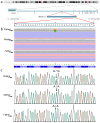PLEKHG1: New Potential Candidate Gene for Periventricular White Matter Abnormalities
- PMID: 39202455
- PMCID: PMC11353482
- DOI: 10.3390/genes15081096
PLEKHG1: New Potential Candidate Gene for Periventricular White Matter Abnormalities
Abstract
Hypoxic-ischemic brain damage presents a significant neurological challenge, often manifesting during the perinatal period. Specifically, periventricular leukomalacia (PVL) is emerging as a notable contributor to cerebral palsy and intellectual disabilities. It compromises cerebral microcirculation, resulting in insufficient oxygen or blood flow to the periventricular region of the brain. As widely documented, these pathological conditions can be caused by several factors encompassing preterm birth (4-5% of the total cases), as well single cotwin abortion and genetic variants such as those associated with GTPase pathways. Whole exome sequencing (WES) analysis identified a de novo causative variant within the pleckstrin homology domain-containing family G member 1 (PLEKHG1) gene in a patient presenting with PVL. The PLEKHG1 gene is ubiquitously expressed, showing high expression patterns in brain tissues. PLEKHG1 is part of a family of Rho guanine nucleotide exchange factors, and the protein is essential for cell division control protein 42 (CDC42) activation in the GTPase pathway. CDC42 is a key small GTPase of the Rho-subfamily, regulating various cellular functions such as cell morphology, migration, endocytosis, and cell cycle progression. The molecular mechanism involving PLEKHG1 and CDC42 has an intriguing role in the reorientation of cells in the vascular endothelium, thus suggesting that disruption responses to mechanical stress in endothelial cells may be involved in the formation of white matter lesions. Significantly, CDC42 association with white matter abnormalities is underscored by its MIM phenotype number. In contrast, although PLEKHG1 has been recently associated with patients showing white matter hyperintensities, it currently lacks a MIM phenotype number. Additionally, in silico analyses classified the identified variant as pathogenic. Although the patient was born prematurely and subsequently to dichorionic gestation, during which its cotwin died, we suggest that the variant described can strongly contribute to PVL. The aim of the current study is to establish a plausible association between the PLEKHG1 gene and PVL.
Keywords: GTPase pathway; cell division control protein 42 (CDC42); next-generation sequencing; periventricular leukomalacia; white matter hyperintensities; whole exome sequencing.
Conflict of interest statement
The authors declare no conflicts of interest.
Figures


References
-
- Nagae L.M., Hoon A.H., Stashinko E., Lin D., Zhang W., Levey E., Wakana S., Jiang H., Leite C.C., Lucato L.T., et al. Diffusion Tensor Imaging in Children with Periventricular Leukomalacia: Variability of Injuries to White Matter Tracts. Am. J. Neuroradiol. 2007;28:1213–1222. doi: 10.3174/ajnr.A0534. - DOI - PMC - PubMed
Publication types
MeSH terms
Substances
Grants and funding
LinkOut - more resources
Full Text Sources
Research Materials
Miscellaneous

